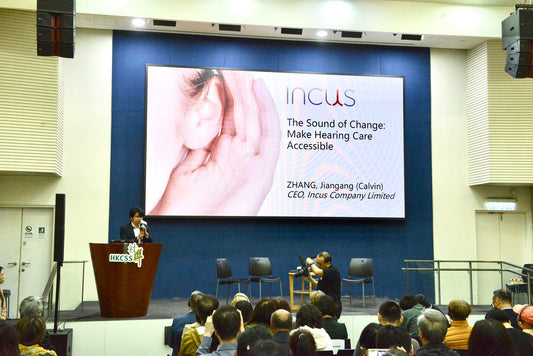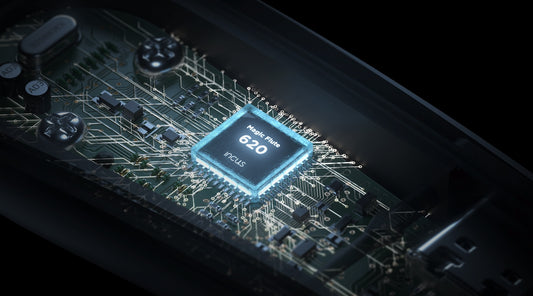Some modern hearing aids come with Bluetooth functionality. While this feature can unlock a world of entertainment, convenience, and communication, it can be hard to appreciate what it is and how it works. In this article, we will explain what Bluetooth hearing aids are and what you should pay attention to when buying yours.
What Are Bluetooth Hearing Aids?
Bluetooth hearing aids are hearing aids but with Bluetooth function added on top. Bluetooth is a wireless communication function that allows you to transfer or stream data between devices. For instance, you can wirelessly stream music from your phone to your Bluetooth hearing aids using the Bluetooth function.
But why does this matter to hearing aids? And could a regular Bluetooth earphone replace this functionality?
The most appealing selling point of a hearing aid is its personalized sound. After conducting hearing tests, sounds can be adjusted by the hearing aid accordingly to your hearing test results to fit your hearing needs. This means sounds can be balanced for people with hearing loss.
However, there is an obstacle: You cannot wear a hearing aid and a Bluetooth earphone at the same time.
One of the problems with using a hearing aid is that it will always be sitting in your ear. In some scenarios, this can get awkward. For instance, when you pick up a phone call and put your phone next to your ear, the hearing aid probably is in your way and does not pick up the sounds from the phone call well. Also, when you want to listen to music with earphones, the hearing aid sitting in your ear will stop you from putting earphones on. Of course, you can take the hearing aid off, but sacrificing hearing to hear things seem ironic, and you won’t be able to enjoy your personalized sound.
This is where Bluetooth hearing aids come into play. They combine the functions of Bluetooth earphones and hearing aids, so you can answer calls or listen to music under the sound assistance and amplification provided by hearing aid, solving the issues of hearing aids and giving the consumers a better experience.
Yet, Bluetooth hearing aids are by no means perfect. Consumers should especially be aware of issues where their desired hearing aids are incompatible with their smartphones.
![]()
Common Compatibility Issues with Bluetooth Hearing Aids
There are two prominent approaches to Bluetooth hearing aids’ interactions with smartphones: MFi (Made For iPhone) hearing aids and MFA (Made For All) hearing aids. Unfortunately, MFi does not support Android, and MFA models are still not widely available. Despite a large Android smartphone userbase, only a few Bluetooth hearing aids on the market are compatible with Android.
Believing that hearing devices should not restrict people from using their favourite smartphone operating system, Incus developed its hearing devices to be compatible across both iOS and Android.

How Incus Hearing Devices Achieve Compatibility with Both iOS and Android
Knowing that universal compatibility would be beneficial to consumers, we opted for an MFA style of Bluetooth, aiming to support multiple platforms. Thus, for Kite 2, we used Bluetooth Low Energy (BTLE), Bluetooth Classic Hands-Free Protocol (BT Classic HFP), and Advanced Audio Profile Distribution (A2DP). This gives our hearing aid the flexibility to connect to a lot more devices:
- BTLE is used when connecting Kite 2 to our app “Yinbei”, which allows users to check power status, change modes, conduct hearing tests, and set up or fine-tune their device;
- BT classic HFP is used during phone calls where it will enable the microphone for communicating;
- A2DP is used for listening to music and radio and disables the microphones temporarily.
Are Bluetooth Hearing Aids Safe?
Electronics can emit radiation. Understandably, some people are cautious about Bluetooth devices. The energy radiated from electronics is called electromagnetic radiation (EMR).
There are two types of EMR: Ionizing EMR and Non-ionizing EMR.
While ionizing EMRs like X-rays can cause immediate damage to our body, Bluetooth is a form of non-ionizing EMR, which does not cause any harm to our body, so it is safe to use.
Besides, consumer electronics devices with Bluetooth functionality require electromagnetic compatibility (EMC) tests before being placed on the market. Bluetooth devices in the United States are subject to requirements by the Federal Communications Commission (FCC), and the corresponding certification in China is called State Radio Regulation of China (SRRC). Other countries also ensure the safety of Bluetooth-enabled devices.
How Much Do Bluetooth Hearing Aids Cost?
Traditional hearing aids with Bluetooth functionality come at a steep price premium compared to those without Bluetooth. If you are purchasing traditional hearing aids, you may have to weigh the cost of a US$ 1,000+ premium against the joy and convenience you would get from Bluetooth functionality.
Kite 2 by Incus comes with Bluetooth included, compatible with phone calls, audio streaming, and hearing device settings. You don’t need to pay extra to enjoy Bluetooth functions, making it an excellent choice if you are looking to buy a Bluetooth hearing aid.
Summary: Read This Before You Purchase Bluetooth Hearing Aids
Before you buy Bluetooth hearing aids, there are always things you should check. This includes:
- Functionality: Can it be used for phone calls and music? Can you change the hearing aids’ settings via Bluetooth? If so, which?
- Connection compatibility: Is it compatible with your phone?
- Safety: Did the Bluetooth fulfill the FCC (or your country’s local equivalent) requirements?
- Price: Do you need to pay more for Bluetooth? Is the price premium worth the benefits you expect to get from this function?



